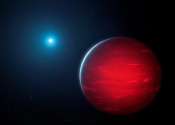Polarized shockwaves shake the universe's cosmic web
ICRAR researchers have discovered tantalizing evidence of magnetic fields in the universe's largest cosmic structures.

ICRAR researchers have discovered tantalizing evidence of magnetic fields in the universe's largest cosmic structures.
Astronomy
Feb 16, 2023
162
329

A mysterious and very distant object, in a universe as it was 'just' two billion years after the Big Bang, hides from even the most advanced instruments. Its features have finally been described by a team from SISSA in a ...
Astronomy
Feb 7, 2023
1
91

Astronomers have released a gargantuan survey of the galactic plane of the Milky Way. The new dataset contains a staggering 3.32 billion celestial objects—arguably the largest such catalog so far. The data for this unprecedented ...
Astronomy
Jan 18, 2023
4
447

Using 12 high-powered lasers, researchers recreated small solar flares in order to study the mechanisms behind a fundamental astronomical phenomenon known as a magnetic reconnection.
Plasma Physics
Dec 8, 2022
0
80

The largest paper ever published on radar observations of near-Earth asteroids has been released, compiling years' worth of data from the Arecibo Observatory in Puerto Rico.
Planetary Sciences
Oct 26, 2022
1
246

The very first stars likely formed when the universe was only 100 million years old, less than one percent its current age. These first stars—known as Population III—were so titanically massive that when they ended their ...
Astronomy
Sep 28, 2022
0
2311

Galactic superwinds—large outflows of gas created by a combination of supernova explosions and stellar winds—are closely connected to a galaxy's earliest stages of development and evolution, including aspects like its ...
Astronomy
Aug 31, 2022
0
176

A citizen scientist has searched NSF's NOIRLab's catalog of 4 billion celestial objects, known as NOIRLab Source Catalog DR2, to reveal brown dwarfs with companions. His intensive investigation led to the discovery of 34 ...
Astronomy
Jul 7, 2022
0
337

Asteroid Bennu's boulder-covered surface gives it protection against small meteoroid impacts, according to observations of craters by NASA's OSIRIS-REx (Origins, Spectral Interpretation, Resource Identification, Security-Regolith ...
Planetary Sciences
Jun 16, 2022
0
332

Ohio State University astronomers have identified about 116,000 new variable stars, according to a new paper.
Astronomy
Jun 1, 2022
0
398